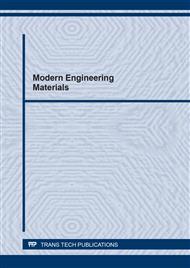[1]
Kolli, R.P., & Devaraj, A. (2018). A review of metastable beta titanium alloys. Metals, 8(7), 506.
DOI: 10.3390/met8070506
Google Scholar
[2]
Kaur, M., & Singh, K. (2019). Review on titanium and titanium based alloys as biomaterials for orthopaedic applications. Materials Science and Engineering: C, 102, 844-862.
DOI: 10.1016/j.msec.2019.04.064
Google Scholar
[3]
Bolzoni, Leandro, Elisa María Ruiz-Navas, and Elena Gordo. Quantifying the properties of low-cost powder metallurgy titanium alloys., Materials Science and Engineering: A 687 (2017): 47-53.
DOI: 10.1016/j.msea.2017.01.049
Google Scholar
[4]
I.J. Polmear, Light Alloys. From Traditional Alloys to Nanocrystals, 4thed., Butterworth-Heinemann, UK, (2006).
Google Scholar
[5]
C. Leyens, M. Peters, Titanium and Titanium Alloys. Fundamentals and Applications, Wiley-VCH, Köln, Germany, (2003).
Google Scholar
[6]
V.A. Joshi, Titanium Alloys: An Atlas of Structures and Fracture Features, Taylor & Francis, NW, U.S.A., (2006).
Google Scholar
[7]
K. Faller, F.S. Froes, The Use of Titanium in Family Automobiles: Current Trends, JOM 53(4) (2001) 27-28.
DOI: 10.1007/s11837-001-0143-3
Google Scholar
[8]
F.H. Froes, M.N. Gungor, M.A. Imam, Cost-affordable Titanium: The Component Fabrication Perspective, JOM 59(6) (2007) 28-31.
DOI: 10.1007/s11837-007-0074-8
Google Scholar
[9]
Imam, M. Ashraf, and FH Sam Froes. Low cost titanium and developing applications., JOM 62, no. 5 (2010): 17-20.
DOI: 10.1007/s11837-010-0069-8
Google Scholar
[10]
Cui, C., Hu, B., Zhao, L. and Liu, S., 2011. Titanium alloy production technology, market prospects and industry development. Materials & Design, 32(3), pp.1684-1691.
DOI: 10.1016/j.matdes.2010.09.011
Google Scholar
[11]
D.J. Lin, C.P. Ju, J.H.C. Lin, Structure and Properties of Cast Ti-Fe Alloys, Transactions of the American Foundrymen's Society, 107 (1999) 859-864.
Google Scholar
[12]
Boyer, R. R. Attributes, characteristics, and applications of titanium and its alloys., JOM 62, no. 5 (2010): 21-24.
DOI: 10.1007/s11837-010-0071-1
Google Scholar
[13]
Froes, F. H. How to market titanium: lower the cost., JOM 56, no. 2 (2004): 39.
DOI: 10.1007/s11837-004-0143-1
Google Scholar
[14]
F.C. Holden, H.R. Ogden, R.I. Jaffee, Heat Treatment and Mechanical Properties of Ti-Fe Alloys, Transactions of the American Institute of Mining and Metallurgical Engineers 206(5) (1956) 521-528.
DOI: 10.1007/bf03377721
Google Scholar
[15]
D.B. Lee, K.B. Park, H.W. Jeong, S.E. Kim, Mechanical and Oxidation Properties of Ti-xFe-ySi Alloys, Materials Science and Engineering A 328(1-2) (2002) 161-168.
DOI: 10.1016/s0921-5093(01)01670-7
Google Scholar
[16]
Majima, T. Hirata, M. Yamamoto, H. Nagai, K. Shouji, Microstructures and Tensile Properties of Hot Isostatically Pressed Ti-Fe Alloys, Journal of the Japan Institute of Metals 52(11) (1988) 1113-1120.
DOI: 10.2320/jinstmet1952.52.11_1113
Google Scholar
[17]
O.M. Ivasishin, Cost-effective Manufacturing of Titanium Parts with Powder Metallurgy Approach, Materials Forum 29 (2005) 1-8.
Google Scholar
[18]
Ivasishin, O.M., Akhonin, S.V., Savvakin, D.G., Berezos, V.A., Bondarchuk V.I., Stasyuk, O.O., Markovsky, P. E., (2018). Effect of microstructure, deformation mode and rate on mechanical behaviour of electron-beam melted Ti-6Al-4V and Ti-1.5Al-6.8Mo-4.5Fe alloys. Progress in Physics of Metals, 19(3) 309-336.
DOI: 10.15407/ufm.19.03.309
Google Scholar
[19]
Makarenko, V., Maksimov, S., & Makarenko, Y. (2021, March). Catode and Anode Processes in Sulfur Corrosion Destruction of Metal Constructions of Prolonged Exploitation in an Aggressive Environment. In IOP Conference Series: Earth and Environmental Science (Vol. 688, No. 1, p.012014). IOP Publishing.
DOI: 10.1088/1755-1315/688/1/012014
Google Scholar
[20]
Akhonin, S. V., Belous, V. Y., & Selin, R. V. (2019, September). Electron Beam Welding, Heat Treatment and Hardening of Beta-Titanium. In IOP Conference Series: Materials Science and Engineering (Vol. 582, No. 1, p.012050). IOP Publishing.
DOI: 10.1088/1757-899x/582/1/012050
Google Scholar
[21]
Saresh, N., Pillai, M. G., & Mathew, J. (2007). Investigations into the effects of electron beam welding on thick Ti-6Al-4V titanium alloy. Journal of Materials Processing Technology, 192, 83-88.
DOI: 10.1016/j.jmatprotec.2007.04.048
Google Scholar
[22]
Akhonin, S. V., Belous, V.Y., Selin, R.V., Kostin, V.A. (2021). Influence of TIG Welding Thermal Cycle on Temperature Distribution and Phase Transformation in Low-cost Titanium Alloy. IOP Conference Series: Earth and Environmental Science, 2021, 688(1), 12012.
DOI: 10.1088/1755-1315/688/1/012012
Google Scholar
[23]
Akhonin, S. V., Belous, V. Y., Berezos, V.A., Selin, R. V. (2018). Effect of TIG-welding on the structure and mechanical properties of the pseudo-β titanium alloy VT19 welded joints. Materials Science Forum, 2018, 927 MSF, 112-118.
DOI: 10.4028/www.scientific.net/msf.927.112
Google Scholar
[24]
О.P. Ostash, V. V Kulyk, V.D. Poznyakov, О.А. Gaivorons'kyi, V.V. Vira, Influence of the Modes of Heat Treatment on the Strength and Cyclic Crack-Growth Resistance of 65G Steel, Mater. Sci. 54 (2019).
DOI: 10.1007/s11003-019-00263-6
Google Scholar
[25]
Markovsky, P. E., Akhonin, S., Berezos, V. A., Bondarchuk, V. I., Stasuk, O. O., Karasevska, O. P., & Gavrysh, I. M. (2020). Microstructure and Tensile Properties of Cost-Efficient Thermally Hardenable α+β Alloys of Ti–Al–Mo–Fe and Ti–Al–Mo–Cr Systems. Metallography, Microstructure, and Analysis, 9(6), 856-872.
DOI: 10.1007/s13632-020-00705-7
Google Scholar


